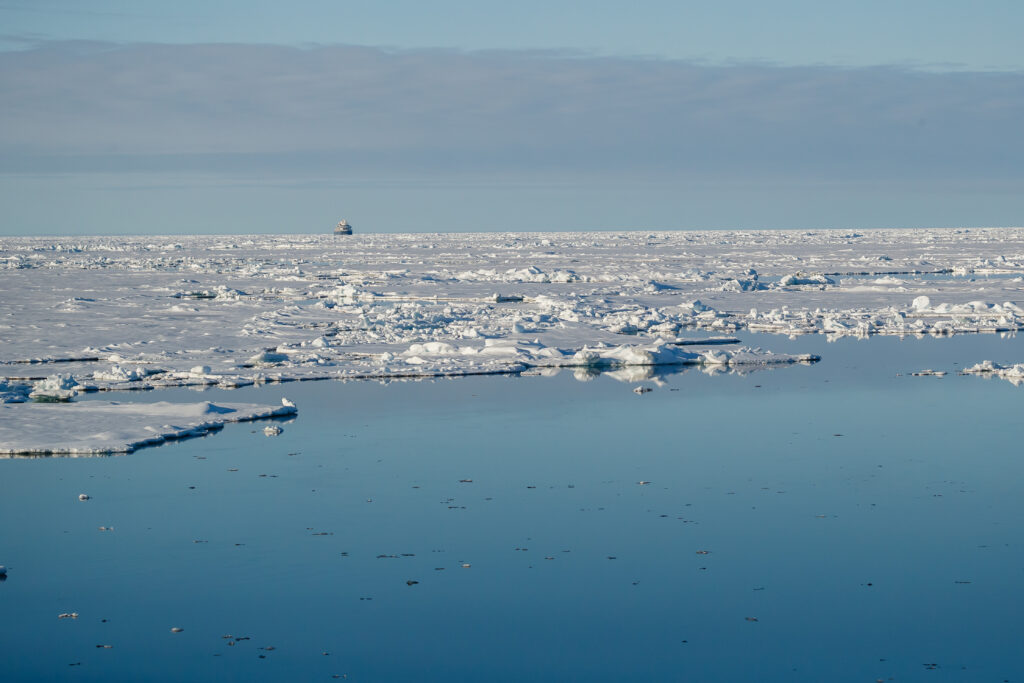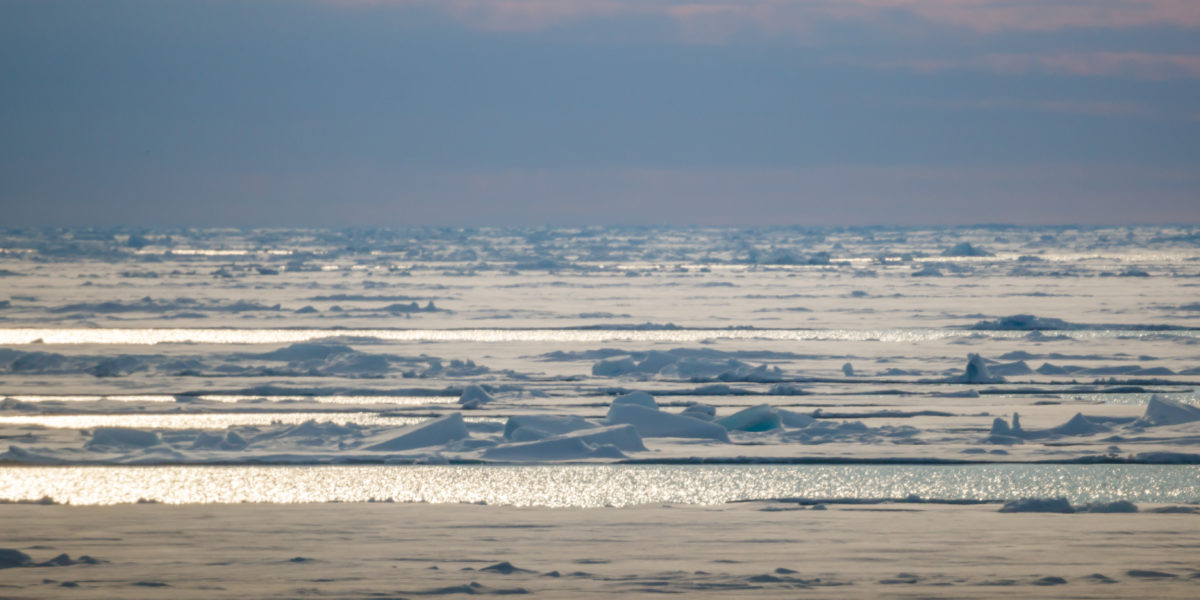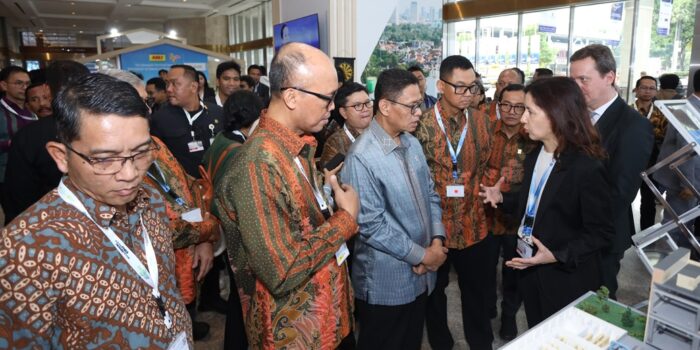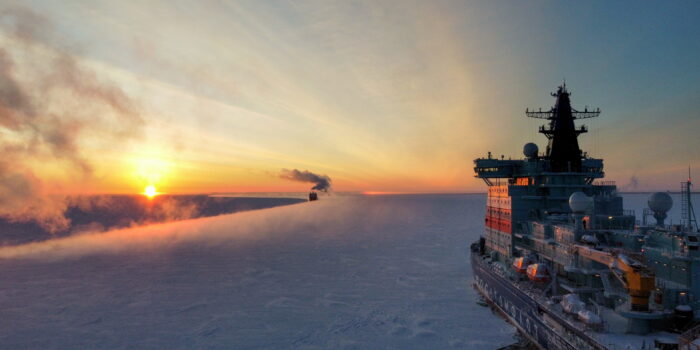Comprehensive development of the Russian Arctic zone is one of the strategic national priorities. Increasing the volume of transportation along the Northern Sea Route (NSR) is of paramount importance to meet the set objectives in the field of cargo transportation and delivery. The development of this logistics corridor is ensured through the establishment of regular cargo shipments, construction of new nuclear icebreakers and modernization of the relevant infrastructure. Rosatom’s enterprises take an active part in this work.
In 2018, Rosatom was designated the infrastructure operator of the NSR.
The integrated development of the Arctic and the transformation of the NSR into a year-round transport and logistics route require the provision of safe and sustainable Arctic shipping; the creation of a modern and efficient port infrastructure involves constant monitoring of the state of the Arctic aquatic and terrestrial ecosystems adjacent to the NSR.
Ensuring the environmental safety of the Arctic is of paramount importance for the development of the region and is only possible with the application of a systemic approach that includes both regulatory and legal support, managerial, navigation and technological solutions, as well as operational interaction of authorities, nature users and the expert community.
One of the most effective mechanisms to obtain necessary information about the state of environment and biodiversity in the Arctic region and their changes is an ongoing environmental monitoring with the greatest possible territorial coverage and the use of state-of-the-art technology. Measures to detect, prevent and eliminate safety risks, localize and neutralize their effects, including remote methods of environmental research prepared in accordance with generally accepted international standards, will help make timely forecasts and analysis of the situation in the northern seas.

To ensure the environmental safety of the region, taking into account global environmental changes, as well as the increasing intensity of navigation along the NSR, work is underway to create an extensive program of comprehensive and systematic environmental research. An important step on this path was a joint project of the Marine Research Center of Lomonosov Moscow State University (MSU MRC) and Rosatom, launched in 2021.
Project goals:
- ensuring sustainable navigation on the NSR;
- comprehensive assessment of the current state of the environment in the NSR water area;
- studying the impact of Arctic shipping and infrastructure development on Arctic biodiversity;
- development of a comprehensive program for monitoring the state of the environment and biodiversity in the NSR water area in accordance with international best practices.
The focus is on coastal and transit Arctic shipping and port infrastructure of the NSR during its construction and operation.
Field works
Field work within the boundaries of the NSR water area was carried out in the summer-autumn season of 2021 and 2022 from the research vessels “Aleksey Maryshev”, “Ivan Kireev”, “Professor Logachev”, “Kartesh”, as well as from the nuclear lighter carrier “Sevmorput”. In 2023, field work was carried out in the waters of the ports of Amderma, Sabetta, Utrenny, Dikson, Dudinka, Khatanga, Tiksi and Pevek.
A network of comprehensive environmental monitoring stations was developed based on an analysis of open literature and stock research data from past years. When arranging stations, the main routes of vessel traffic along the NSR and the location of areas of increased importance (walrus rookeries, areas of their feeding, migration and wintering, areas of molting, migration, breeding and feeding of birds, etc.) were taken into account.
During the period of work at the stations, atmospheric air was studied, samples of sea water and bottom sediments, microplastics were taken, the temperature and salinity of the water column were measured, and large debris was recorded. The study of the biota of the Arctic seas included sampling to analyze the quantitative and qualitative indicators of planktonic and benthic communities, as well as to study the presence of biological invasions, which is important for forming a comprehensive picture of the state of the Arctic marine ecosystems. Observations were made of marine mammals and birds.
Laboratory research and office processing of data obtained
Between October and December in 2021, 2022 and 2023, in specialized laboratories in Moscow and St. Petersburg, samples were processed and further desk analysis of materials obtained during field work was carried out.
Experts analyzed 100 samples of atmospheric air, 400 samples of sea water for more than 35 parameters and about 130 samples of bottom sediments for more than 30 parameters. Hydrobiologists processed more than 1,200 plankton samples, including bacterioplankton, phytoplankton, zooplankton and ichthyoplankton, as well as about 600 benthos samples, including macrobenthos, meiobenthos, microphytobenthos.
Research has shown that in the summer-autumn periods, the estimated parameters for most indicators had values characteristic of the seasons and regions of observation.

No excessive maximum permissible concentrations were recorded in the atmospheric air, seawater, or bottom sediments that could indicate a detrimental impact of economic activities at this stage of the NSR development and intensity of navigation.
Digital service
In 2021-2023 а project for a digital service for satellite environmental monitoring of ship loads and pollution in the NSR water area was implemented. The first results of the digital services were obtained.
Ship traffic density during the monitoring period was analyzed based on data from the Automatic Identification System (AIS).
International interaction
A key condition for the sustainable development of shipping along the NSR is its compliance with international environmental standards and best environmental practices.
MSU MRC created an international group of experts for environmental monitoring of the NSR (hereinafter referred to as IGE), which became an international forum for discussing the concept and implementation of the project.
The purpose of IGE is to evaluate the environmental monitoring framework of the NSR and to develop recommendations for its improvement.
IGE participants are experts on birds, zoo- and phytoplankton, marine mammals, fish, etc., representing more than 18 leading Russian and foreign organizations in the field of environmental protection and conservation of biological diversity. Among them are such organizations as the Institute of Oceanology named after P. P. Shirshov RAS, Institute of Ecology and Evolution named after A. N. Severtsov RAS, Arctic and Antarctic Research Institute, Murmansk Marine Biological Institute of the Kola Scientific Center RAS, etc. Over the course of three years, representatives of leading scientific institutions from Norway, Finland, France, Iceland, Great Britain, China, India, Egypt, Malaysia, Turkey took part in the project.
Results
As a result of the work, a comprehensive program for monitoring the state of the environment and biodiversity in the NSR water area was formed.
Program includes:
- a system of measures to monitor and control the state of the environment in the NSR water area, taking into account Russian government, commercial, scientific and non-profit organizations and the foreign expert community;
- environmental monitoring subprograms with the definition of a set of mandatory objects, parameters, methods, frequency of observations and work areas. Subroutines are developed for abiotic (atmospheric air, sea waters, sea ice, bottom sediments) and biological objects (bacterio-, phyto-, zooplankton, macrozoo-, microphytobenthos, ichthyofauna, avifauna, marine mammals);
- testing grounds for monitoring and observing birds and marine mammals.
The project does not stop and will be implemented in 2024. In September 2023, within the framework of the Eastern Economic Forum (EEF), a document was signed on the continuation of cooperation between the Rosatom State Corporation and MSU MRC.
The information brochure Programme of Complex Research and Monitoring of Surface and Underwater Environmental Safety of the Northern Sea Route is available by link.





